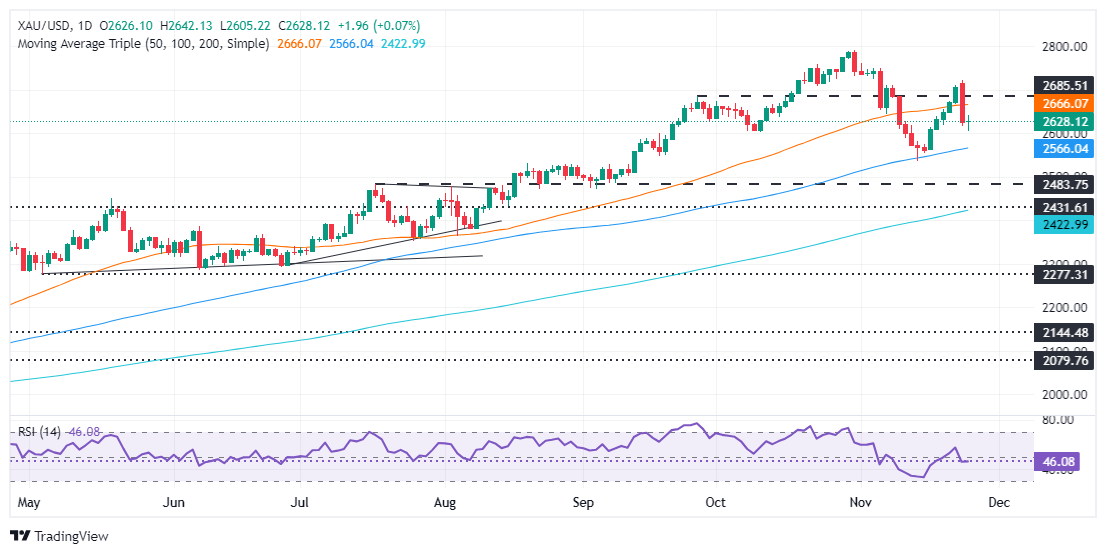- The price of Gold remains unchanged at $2,625, held back by a mix of geopolitical developments and a stronger US Dollar.
- Trump threatens tariffs on Canada, Mexico and China, boosting the dollar and raising fears of a global trade war.
- Optimism of a ceasefire between Israel and Hezbollah reduces Gold’s appeal as a safe haven asset.
Gold prices remain stuck around $2,625 for the second day in a row, despite US President Donald Trump threatening to impose tariffs on three of his main trading partners in a post on his social media platform. social. Typically, the gold metal should rise on geopolitical uncertainties, but a de-escalation in the Middle East conflict cooled the precious metal.
XAU/USD is trading at $2,625, virtually unchanged. Meanwhile, the latest minutes of the Federal Open Market Committee (FOMC) were released. They hinted that the Federal Reserve could pause reducing rates and keep them at restrictive levels if inflation remains high.
Trump’s intentions to impose tariffs on Canada, Mexico and China boosted the dollar, raising fears of a global trade war.
The Bullion’s collapse on Monday was exacerbated by optimism for a ceasefire between Israel and Hezbollah and pressured by the nomination of Scott Bessent as US Treasury Secretary for the incoming Trump administration. This improved risk appetite, affecting demand for gold as a safe haven.
However, Gold’s losses were limited, if not due to the escalation of the conflict between Ukraine and Russia. This prevented XAU/USD from falling below $2,600 per troy ounce, even though the dollar regained some ground.
In terms of data, the US economic agenda included the Conference Board’s (CB) consumer confidence release in November, which beat estimates and October’s number,
For this week, the US economic agenda will include durable goods orders, initial jobless claims and the Fed’s preferred inflation indicator, the Personal Consumption Expenditure (PCE) Price Index.
Daily Market Summary: Gold Prices Fluctuate Around $2,620
- Gold prices recovered as US real yields rose eight basis points to 2.014%.
- The US Dollar Index rises by more than 0.16%, reaching 107.00.
- The CME’s FedWatch tool suggests investors see a 59% chance of a 25 basis point rate cut at the US central bank’s December meeting, up from 52% yesterday.
- Conference Board Consumer Confidence for November expanded to 111.7, from 109.6, beating estimates of 111.3
- Data from the Chicago Board of Trade, via the December federal funds rate futures contract, shows that investors are estimating a 22 bp easing by the Fed by the end of 2024.
Technical outlook: Gold price declines, consolidates around 50- and 100-day SMAs
Gold price is neutral to bearish after sellers pushed the Bullion below the $2,700 mark. Furthermore, XAU/USD is forming a series of successively lower highs and lower lows. If the bears push prices below $2,600, the door will open to test the 100-day SMA of $2,565, followed immediately by the November 14 low of $2,536.
Conversely, if buyers reclaim the 50-day SMA at $2,665, this could pave the way to challenge $2,700. Once broken, the next stop would be $2,750, before the all-time high at $2,790.
Oscillators like the Relative Strength Index (RSI) have turned bearish, indicating that sellers are in charge.
Gold FAQs
Gold has played a fundamental role in human history, as it has been widely used as a store of value and medium of exchange. Today, apart from its brilliance and use for jewelry, the precious metal is considered a safe-haven asset, meaning it is considered a good investment in turbulent times. Gold is also considered a hedge against inflation and currency depreciation, since it does not depend on any specific issuer or government.
Central banks are the largest holders of Gold. In their aim to support their currencies in turbulent times, central banks tend to diversify their reserves and purchase Gold to improve the perception of strength of the economy and currency. High Gold reserves can be a source of confidence for the solvency of a country. Central banks added 1,136 tons of gold worth about $70 billion to their reserves in 2022, according to data from the World Gold Council. This is the largest annual purchase since records exist. Central banks in emerging economies such as China, India and Türkiye are rapidly increasing their gold reserves.
Gold has an inverse correlation with the US Dollar and US Treasuries, which are the main reserve and safe haven assets. When the Dollar depreciates, the price of Gold tends to rise, allowing investors and central banks to diversify their assets in turbulent times. Gold is also inversely correlated with risk assets. A rally in the stock market tends to weaken the price of Gold, while sell-offs in riskier markets tend to favor the precious metal.
The price of Gold can move due to a wide range of factors. Geopolitical instability or fear of a deep recession can cause the price of Gold to rise rapidly due to its status as a safe haven asset. As a non-yielding asset, the price of Gold tends to rise when interest rates fall, while rising money prices tend to weigh down the yellow metal. Still, most of the moves depend on how the US Dollar (USD) performs, as the asset is traded in dollars (XAU/USD). A strong Dollar tends to keep the price of Gold in check, while a weaker Dollar is likely to push up Gold prices.
Source: Fx Street
I am Joshua Winder, a senior-level journalist and editor at World Stock Market. I specialize in covering news related to the stock market and economic trends. With more than 8 years of experience in this field, I have become an expert in financial reporting.








